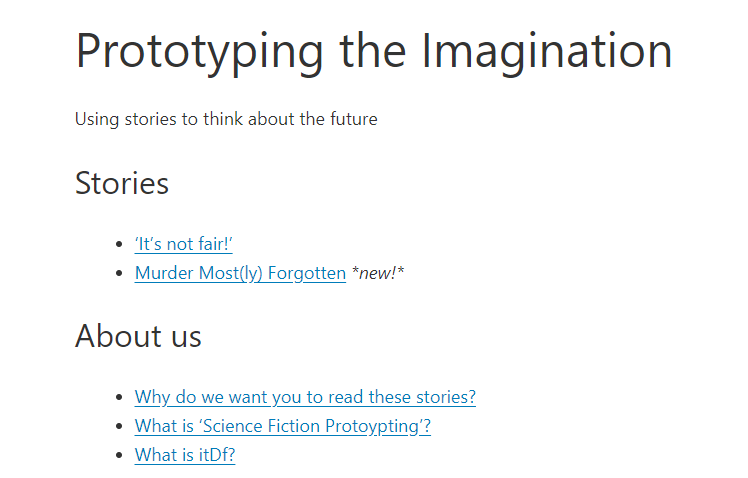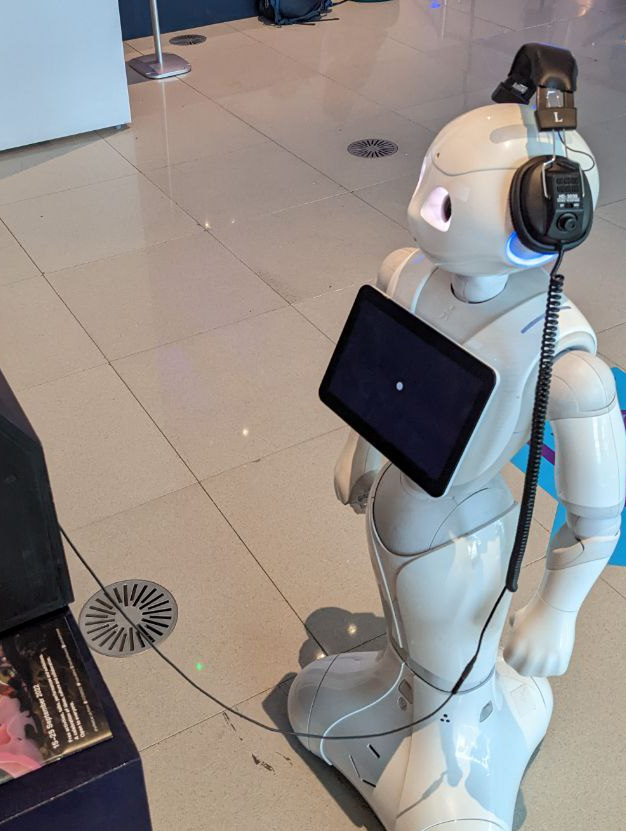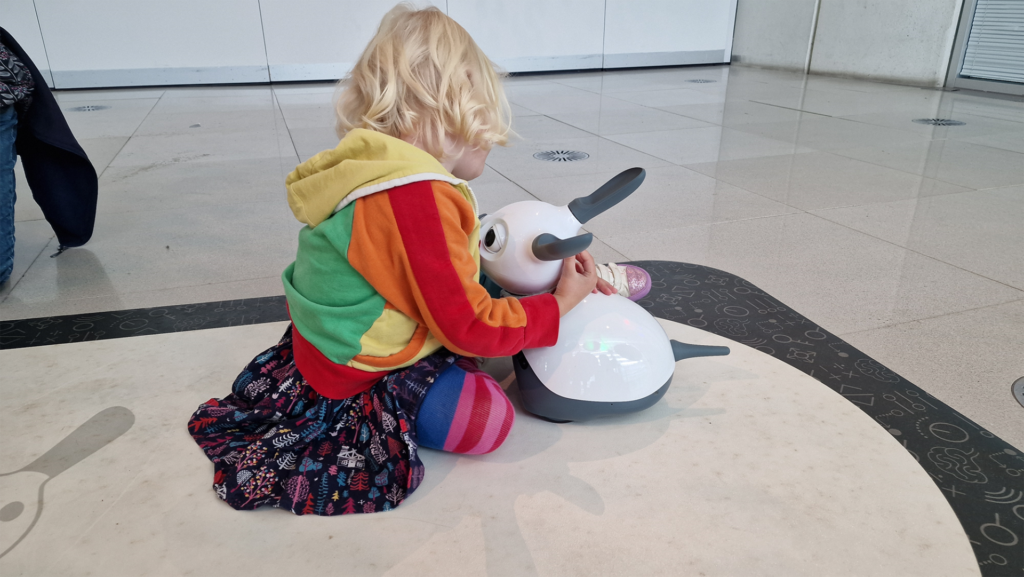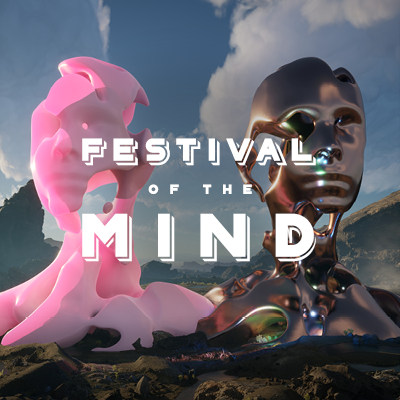In September, itDf was represented at Sheffield’s biennial Festival of the Mind, the public-facing celebration of the University of Sheffield’s research featuring collaborations with local artists and partners in industry.
After the 2020 event was moved online due to the COVID-19 pandemic, it was fantastic to be back at the Millennium Galleries for the always-entertaining Futurecade exhibition.
Our itDf stand was coordinated by Dr Michael Szollosy, of the Department of Computer Science and Sheffield Robotics, who was assisted by Chrissie Stimson, our PhD student in Sheffield working on itDf. Michael and Chrissie were also helped by a dedicated team of young roboticists from The University of Sheffield who could talk about the aims of itDf and the technology more widely (and help keep it running for so many hours!).
Over an eleven-day period – not including Monday, 19th September, when the Futurecade was closed out of respect for the funeral of Queen Elizabeth II – we welcomed well over four and half thousand visitors to our stand at the Millennium Galleries.
The itDf stand comprised two main attractions: a prototype of our new science-fiction prototyping application, and a demonstration of telepresence and the possibilities it opens for an inclusive society.
Prototyping the Imagination
ItDf is very interested in how we use stories to understand our potential futures and how technology might transform our societies. Some earlier work in this area has been called ‘Science Fiction Prototyping’, where writers can use stories about future technologies to help understand how these technologies might impact our societies, and how they might be perceived, for better or for worse, by people today.
Here in Sheffield, we are combining this idea of science fiction prototyping with interactive storytelling in order to both find out what people think about future technologies, and to try to understand how we perceive that these technologies might impact the way we live in the future. We are creating an app called Prototyping the Imagination, through which we will deliver these stories to readers, who get to choose the direction that the stories take by making decisions about what characters do or say next, or engaging with the events of the story in other creative ways.

For example, in ‘It’s not Fair!’, parents must deal with their child’s desire to have neurological implants; readers have to weigh the child’s arguments and decide whether to allow a device to be implanted. In ‘Murder Mostly Forgotten’, readers get a chance to see what a suspect interrogation might look like in a world where the human capacity to remember the past is purchased and installed in people the way we install memory in computers today.
Each story offers the reader a chance to interact with the events of the story in different ways, and offers links to articles that explain something of the science and thinking that inspired the narrative.
Following (what we think was) a very successful trial at Festival of the Mind, we are taking the app back to the drawing board. When we re-launch in the coming months, we will offer these stories and many more through a more self-contained application, having learned important lessons (about what readers like and don’t like, what works and what doesn’t in this format), and offering a much slicker, better-integrated interface for readers.
In the coming months, too, we will be adding to the stories on offer. We are planning to hold some workshops with itDf researchers and creative writers; we hope that by speaking to one another, we will create better and more compelling stories: writers can learn more about the technologies around which they are building their stories, and the itDf team, and researchers/engineers developing these technologies, can get better understanding as to how their innovations might be perceived by the public at large, or what sorts of narratives might develop around them.
If you are interested in contributing to this process, in any capacity, please contact Michael Szollosy at m.szollosy@sheffield.ac.uk.
Telepresence: Different ways of being
Also at our itDf stand at the Millennium Galleries, we offered visitors a chance to experience first-hand telepresence, the feeling of being in a remote location. In our case, we are able to deliver immersive telepresence: going beyond your usual Teams video call, we put an Oculus Quest headset on visitors who would then be able to control a robot as if they were inside the robot. They would see what the robot could see, hear what the robot could hear, and in some cases, move about the Millenium Galleries, interacting with the other visitors and exhibits in the robot’s body.

Telepresence, we feel, is one of those transformative technologies that have the potential to change the way we live and interact with one another.
We can use teleoperated robots to hug loved ones oceans away, or to protect people doing extremely dangerous work. Immersive telepresence with robots can enable us to connect with each other in post-COVID world; it can help carers check in on clients remotely and automatically call for help in an emergency, and contribute to enhancing lives by facilitating more emancipated futures.
As a research tool, too, immersive telepresence robotics has intriguing implications for feelings of selfhood and subjective experience. Through such systems, we can experience real ‘out of body’ feelings, when we seem to exist in two places at once. It also allows us to re-examine in new ways important, fundamental questions about disability, empathy, experience, and out bodies,
As we did with our Robots Lab Live event back in the summer (stay tuned as we’ll soon offer a highlights package here), we hope that these demonstrations of state-of-the-art telepresence technologies will help people engage with different ideas of what a more inclusive future might look like, where our bodies can be transformed, we can interact with remote environments and one another in new ways, and where physical space and limitations are not necessarily a bar to new experiences.
This exciting experience is made possible through our partnership with BOW Software, who have developed a telepresence platform for robotics (and were just about to go to Los Angeles for the finals of the ANA Avatar XPRIZE), and with Sheffield Robotics, who lent us the use of their Pepper and MiRo robots. BOW also provided a small robot head from OhBot, another industry partner.
Stay tuned to learn more about our science fiction prototyping application, and our hands-on telepresence demonstrations – hopefully coming to an event near you soon.


